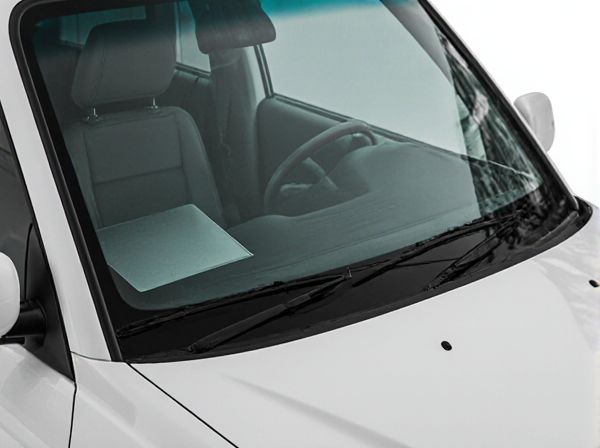
Photo illustration: Solar Control Windshield vs Regular Windshield
A solar control windshield significantly reduces heat and harmful UV rays entering your vehicle compared to a regular windshield, enhancing comfort and protecting your interior. It features a special coating or film that reflects solar energy while maintaining visibility and safety standards. Choosing a solar control windshield helps keep your car cooler, reducing the need for air conditioning and improving fuel efficiency.
Table of Comparison
| Feature | Solar Control Windshield | Regular Windshield |
|---|---|---|
| Heat Reduction | Blocks up to 60% of solar heat | Minimal heat rejection |
| UV Protection | Blocks up to 99% UV rays | Limited UV protection |
| Glare Reduction | Reduces sun glare significantly | Standard glare control |
| Energy Efficiency | Improves vehicle AC efficiency | No impact on AC efficiency |
| Cost | Higher initial investment | Lower upfront cost |
| Durability | Enhanced longevity due to heat resistance | Standard durability |
Introduction to Windshield Technologies
Solar control windshields incorporate advanced infrared-reflective coatings that significantly reduce heat buildup inside the vehicle, enhancing passenger comfort and lowering air conditioning usage. Regular windshields primarily emphasize basic impact resistance and clarity but lack specialized technologies to block solar radiation effectively. Innovations in solar control windshield technology focus on integrating UV and infrared filtering capabilities while maintaining optical transparency and structural safety.
What Is a Solar Control Windshield?
A solar control windshield is designed with a special coating or interlayer that reflects and absorbs solar radiation, reducing heat buildup inside the vehicle and protecting occupants from harmful UV rays. Unlike regular windshields, which primarily offer basic visibility and safety, solar control windshields enhance comfort by maintaining a cooler cabin temperature and improving energy efficiency. These windshields contribute to lower air conditioning use and increased durability by minimizing sun damage to the interior components.
Understanding Regular Windshields
Regular windshields are typically made from laminated glass designed to provide durability and safety by preventing shattering upon impact. These windshields primarily block UVB rays but allow a significant amount of UVA rays to penetrate, which can contribute to interior fading and increased cabin temperature. Unlike solar control windshields, regular ones lack specialized coatings or tints aimed at reducing heat buildup and protecting against infrared radiation.
Key Differences Between Solar Control and Regular Windshields
Solar control windshields use a special coating or layer to filter infrared and ultraviolet rays, reducing heat and glare inside the vehicle, while regular windshields lack these protective properties. The solar control glass improves energy efficiency by minimizing the need for air conditioning, enhancing passenger comfort on hot days. In contrast, regular windshields primarily provide basic protection against debris and wind without significant heat reduction capabilities.
UV and Heat Protection: Solar Control Benefits
Solar control windshields provide superior UV protection by blocking up to 99% of harmful ultraviolet rays, significantly reducing skin damage and interior fading compared to regular windshields. They also offer enhanced heat rejection, lowering cabin temperatures and improving fuel efficiency by reducing the need for excessive air conditioning. This advanced technology results in greater occupant comfort and prolonged durability of vehicle interiors.
Energy Efficiency and Vehicle Comfort
Solar control windshields utilize specialized coatings or films that block infrared and ultraviolet rays, significantly reducing cabin heat buildup and enhancing vehicle energy efficiency by lessening the demand on air conditioning systems. Regular windshields lack these advanced properties, often resulting in higher interior temperatures and increased fuel consumption to maintain comfort levels. Improved thermal regulation with solar control glass contributes to a more comfortable driving experience and reduces environmental impact through lower energy use.
Impact on Driving Visibility and Safety
Solar control windshields significantly reduce glare and block harmful UV rays, enhancing driving visibility and comfort compared to regular windshields. By maintaining clearer visibility in bright sunlight and reducing eye strain, they contribute to safer driving conditions. The improved light filtration also helps protect the interior components and reduces the risk of heat-related damage, further supporting driver safety.
Cost Comparison and Long-Term Value
Solar control windshields typically cost 20-30% more than regular windshields due to advanced heat-reducing coatings and UV protection technology. The higher initial investment is offset by long-term energy savings, reduced interior fading, and improved cabin comfort, which may lower air conditioning usage and enhance vehicle resale value. Regular windshields lack these benefits, potentially resulting in higher cooling expenses and faster interior wear over time.
Maintenance and Durability Considerations
Solar control windshields feature a special coating that reduces heat and UV radiation, minimizing interior damage and decreasing cleaning frequency compared to regular windshields. Their enhanced durability includes resistance to discoloration and deterioration caused by sun exposure, extending the lifespan of the glass. Regular windshields, lacking this protective layer, often require more frequent maintenance due to faster degradation and increased heat-related stress.
Choosing the Right Windshield for Your Vehicle
Solar control windshields reduce heat buildup and block UV rays, providing enhanced comfort and protection compared to regular windshields. Selecting the right windshield depends on your climate, driving habits, and budget, with solar control options ideal for sunny regions to minimize interior temperature and glare. Ensure compatibility with your vehicle's make and model while considering energy efficiency and safety certifications for optimal performance.
 caratoz.com
caratoz.com